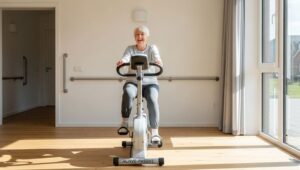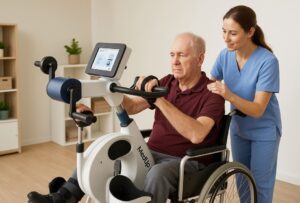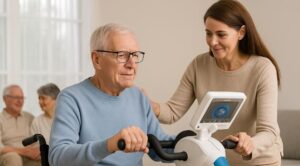
During rehabilitation therapy following an illness, injury or diagnosis, a patient will take part in a number of exercises and routines. These therapeutic routines are done with the goal of maintaining or improving movement in a limb or set of limbs. Therapies can be performed with both active and passive support from the therapist and their tools. One common rehab tool they frequently incorporate is a cycle trainer. These therapeutic machines are outfitted with a number of training modes that can assist the user throughout their recovery efforts, based on the level of assistance the patient needs.
What is passive therapy?
The term passive therapy refers to the effort required by the patient during an exercise or rehabilitation routine created by a physical therapist. Passive therapy does not require the patient to use physical force to participate in their treatment. Instead, the physical force is applied by either the therapist or a mechanical training mode on an exercise training machine like a cycle trainer or ergometer.
Benefits of passive therapy mode on an exercise trainer
A cycle trainer is a great tool in an effective physical therapy routine. Whether the patient is able to perform physical activity using their own force or will rely on supports that work the muscles in a more passive way, an exercise machine like a motor-assisted cycle trainer is a good option. The option to use both active and passive modes at varying points in the rehabilitation process mean that the patient is able to cater their treatment to their specific needs each day.
There are many benefits to motor-driven passive therapy modes on a cycle trainer.
1. Built-in spasm release offers comfort and safety
Muscle spasms are an often-painful occurrence for those dealing with reduced function and mobility after an accident or health event. A cycle trainer that offers a built-in spasm detection function can help reduce discomfort and pain during the training session should a spasm occur.
2. Helps treat and reduce spasticity
Muscles that aren’t able to be stretched enough, whether through regular use or adequate stretching and training, often tense uncontrollably causing discomfort and pain. Committing to a regular exercise program can help reduce the occurrence of spasticity even after the routine is completed.
3. Improves joint function
Joints need consistent movement to maintain function and mobility, even in patients who are bedbound. Passive mode on a cycle trainer can help patients stretch and move their joints when they aren’t able to perform the movement themselves.
4. Helps increase muscle strength
Regular exercise helps to maintain and increase muscle strength, especially for those who are working towards a movement goal. The ability to change modes on an exercise trainer means that the patient can work their muscles as much as possible with their own strength, while also supplementing with assisted or passive modes as needed.
5. Improves or maintains mobility
Muscles and joints require regular movement to prevent stiffening and retraction. Using passive therapy in the form of a cycle trainer with assisted or passive training modes can help keep limbs moving, even when there are barriers to movement.
6. Better recovery process
Maintaining movement, even when a patient’s strength doesn’t allow them to complete the activity of their own accord, can help promote a faster recovery process. Often the body needs movement to aid in recovery and early mobilization, even with the use of passive therapy, can be beneficial.
Passive mode is an excellent source of support
An active-passive cycle trainer is an ideal addition to a rehabilitation or recovery routine for most patients. While implementing a therapy routine it can be difficult for some patients to find motivation or support to complete the tasks they need to in order to further their recovery. An at-home cycle trainer is an ideal tool to include in a recovery plan, especially if it offers multiple modes of support. A passive training mode allows patients to experience the benefits of maintaining mobility, even when their muscles aren’t yet able to complete the task independently.





